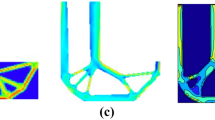Abstract
In this sequel paper, the previously presented framework for the planning and optimisation of functionally graded components Biermann et al. (Prod Eng Res Dev 7(6):657–664, 2013) is applied within a case study. In addition to the application, the implementational infrastructure of the framework is provided and the preliminaries for applying the framework to the respective production system are presented. Hence, the practical realisation of the models and methods is documented. In the context of the case study, each step of the planning process is demonstrated in a visually assisted way. These visualisations are based on the specific steps of the wizard guiding the planner through the framework. As a central contribution, the specification of a non-trivial gradation and the planning of the corresponding process chain by means of the planning framework are demonstrated.




















Similar content being viewed by others
References
Auger A, Hansen N (2005) A restart CMA evolution strategy with increasing population size. In: Proceedings of 2005 IEEE congress on evolutionary computation (CEC 2005), IEEE, pp 1769–1776
Biermann D, Gausemeier J, Heim HP, Hess S, Petersen M, Ries A, Wagner T (2012) Computer-aided planning and optimisation of manufacturing processes for functional graded components. In: Heim HP, Biermann D, Maier HJ (eds) Proceedings of the 1st international conference on thermo-mechanically graded materials, Verlag Wissenschaftliche Scripten, Auerbach, pp 195–200
Biermann D, Gausemeier J, Hess S, Petersen M, Wagner T (2013) Planning and optimisation of manufacturing process chains for functionally graded components—part 1: methodological foundations. Prod Eng Res Dev 7(6):657–664
Biermann D, Gausemeier J, Hess S, Petersen M, Wagner T (2013) Planning methods for manufacturing functionally graded components—challenges and solutions. In: Homberg W, Biermann D, Heim HP (eds) Functionally graded materials in industrial mass production—fundamentals. Verlag Wissenschaftliche Skripten, Auerbach, pp 145–154
Biermann D, Gausemeier J, Hess S, Petersen M, Wagner T (2013) Synthesis and multi-objective model-based optimisation of process chains for manufacturing components with functionally graded properties. In: Heim HP, Biermann D, Homberg W (eds) Functionally graded materials in industrial mass production, vol 2. Verlag Wissenschaftliche Scripten, Auerbach, pp 341–356
Biermann D, Heim HP, Homberg W (2013) Functionally Graded products for the requirements of tomorrow: 1. In: Heim HP, Biermann D, Homberg W (eds) Functionally graded materials in industrial mass production, vol 2. Verlag Wissenschaftliche Scripten, Auerbach, pp 11–20
Bledzki AK, Paßmann D, Ries A (2009) Thermo-mechanical match mould forming of self-reinforced thermoplastic gradient materials. In: Steinhoff K, Maier HJ, Biermann D (eds) Functionally graded materials in industrial mass production. Verlag Wissenschaftliche Scripten, Auerbach, pp 111–127
Elsnegg K, Jung L, Gruber M (2008) Türinnenverkleidungen kostengünstig veredelt. Kunststoffe 98(3):104–107
Fallböhmer M (2000) Generieren alternativer Technologieketten in frühen Phasen der Produktentwicklung. PhD thesis, RWTH Aachen, Laboratory for Machine Tools and Production Engineering (WZL) and Fraunhofer Institute for Production Technology (IPT), Aachen
Gausemeier J, Bauer F, Dettmer D, Reyes-Perez M (2010) Planning of manufacturing processes for graded components. In: Biermann D, Tekkaya AE, Tillmann W (eds) Proceedings of the 1st international conference product property prediction (P3), Dortmund, pp 177–187
Hansen N (2012) CMA evolution strategy source code.https://www.lri.fr/hansen/cmaes_inmatlab.html
Harrington J (1965) The desirability function. Ind Qual Control 21(10):494–498
ISO 10303–210:2002 (2002) Industrial automation systems and integration - product data representation and exchange—part 210: application protocol: electronic assembly, interconnected and packaging design (ISO 10303–210:2001). German Version EN ISO 10303–210:2002
ISO 6603–2:2002 (2000) Plastics—determination of puncture impact behaviour of rigid plastics—part 2: instrumented puncture test (ISO 6603–2:2000). German Version EN ISO 6603–2:2000
Lophaven SN, Nielsen HB, Sondergaard J (2002) DACE—A matlab kriging toolbox. http://www.imm.dtu.dk/~hbni/dace/
Paßmann D (2009) Polypropylen-Faserverbunde beim Heißkompaktieren und Umformen. PhD thesis, Institut für Werkstofftechnik, Kunststoff- und Recyclingtechnik, Universität Kassel
Petersen M, Bauer F, Hess S, Gausemeier J, Gräßler I (2014) Towards a production system specification technique for functionally graded components. In: Marjanovic D, Storga M, Pavkovic N, Bojcetic N (eds) Proceedings of the 13th international DESIGN conference (DESIGN 2014). Faculty of Mechanical Engineering and Naval Architecture, University of Zagreb/The Design Society, Glasgow, 13th International DESIGN Conference, vol 2, pp 1157–1166
Petersen M, Gausemeier J, Iwanek P, Schneider M (2014b) Methodik zur Berücksichtigung von Wechselwirkungen zwischen Produkt und Produktionssystem in den frühen Phasen der Produktentwicklung—Ein Praxisbeispiel. In: Schenk M (ed) Digitales Engineering zum Planen, Testen und Betreiben technischer Systeme, Fraunhofer IFF, IFF-Wissenschaftstage, vol 17, pp 13–21
Rottig HJ (2006) Der Schritt von der Türinnenverkleidung zum Türmodul. Kunststoffe 96(10):113–116
Tönshoff HK, Denkena B, Friemuth T, Zwick M, Brandes A (2002) Technological interfaces of industrial process chains. Prod Eng Res Dev 9(2):43–46
Wagner T (2013) Planning and Multi-objective optimization of manufacturing processes by means of empirical surrogate models. Vulkan Verlag, Essen
Wagner T, Paßmann D, Weinert K, Biermann D, Bledzki AK (2008) Efficient modeling and optimization of the property gradation of self-reinforced polypropylene sheets within a thermo-mechanical compaction process. In: Teti R (ed) Proceedings of 6th CIRP international conference intelligent computation in manufacturing engineering (CIRP ICME ’08), Naples, Italy, Edizione Ziino, C. mare di Stabia and NA, pp 447–452
Acknowledgments
This contribution is based on investigations of the subproject D5 “Synthesis and multi-objective model-based optimisation of process chains for manufacturing components with functionally graded properties” and subproject A5 “Thermomechanical match mould forming of self-reinforced thermoplastic gradient materials”. Both projects are part of the Collaborative Transregional Research Centre (CRC) Transregio 30, which is kindly supported by the German Research Foundation (DFG).
Author information
Authors and Affiliations
Corresponding author
Rights and permissions
About this article
Cite this article
Biermann, D., Gausemeier, J., Heim, HP. et al. Planning and optimisation of manufacturing process chains for functionally graded components—part 2: case study on self-reinforced thermoplastic composites. Prod. Eng. Res. Devel. 9, 405–416 (2015). https://doi.org/10.1007/s11740-015-0610-2
Received:
Accepted:
Published:
Issue Date:
DOI: https://doi.org/10.1007/s11740-015-0610-2




